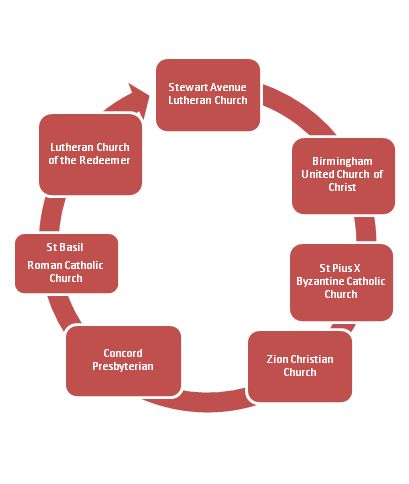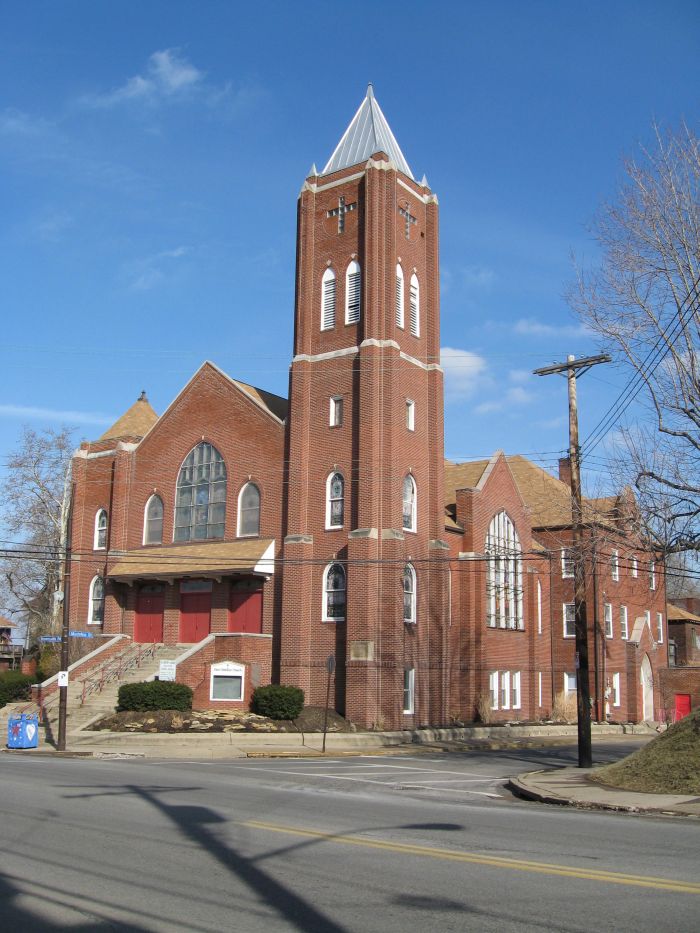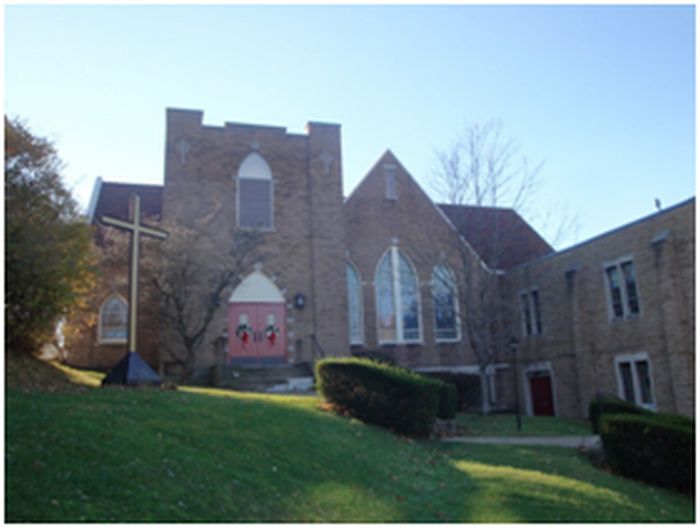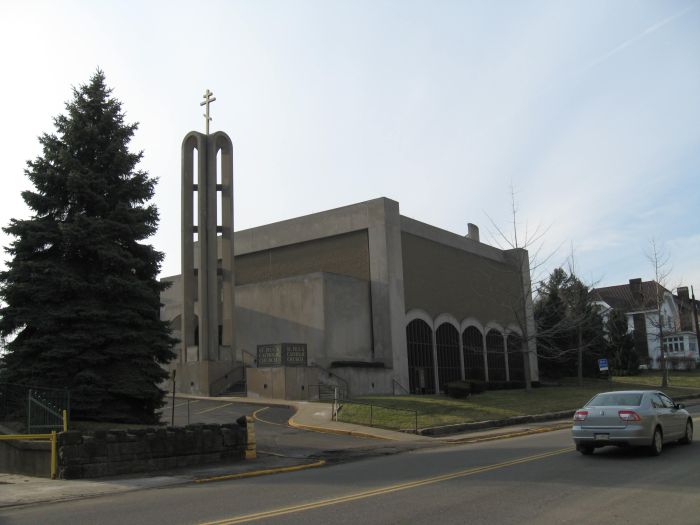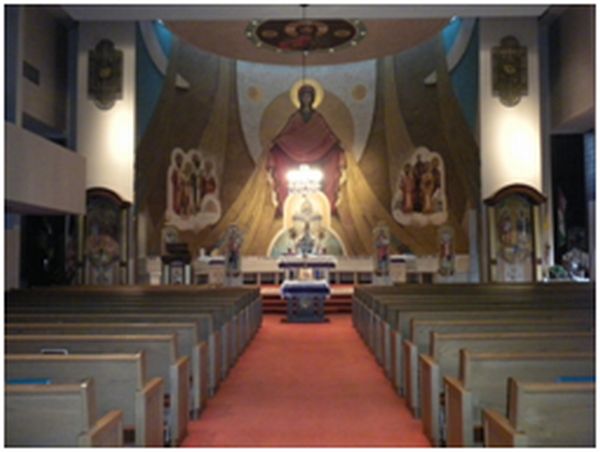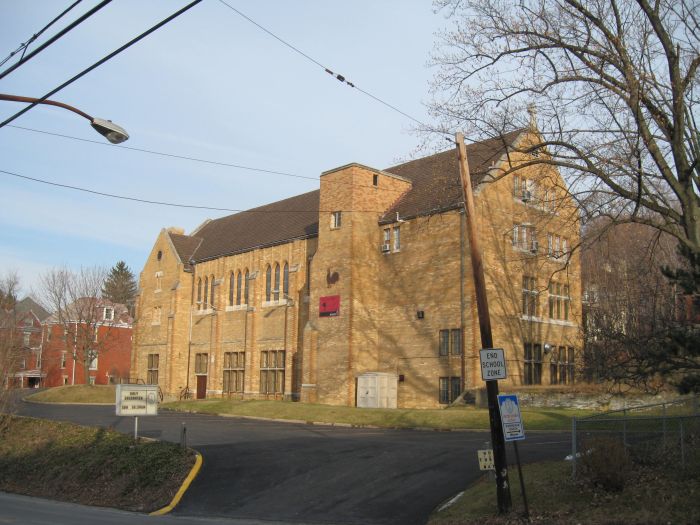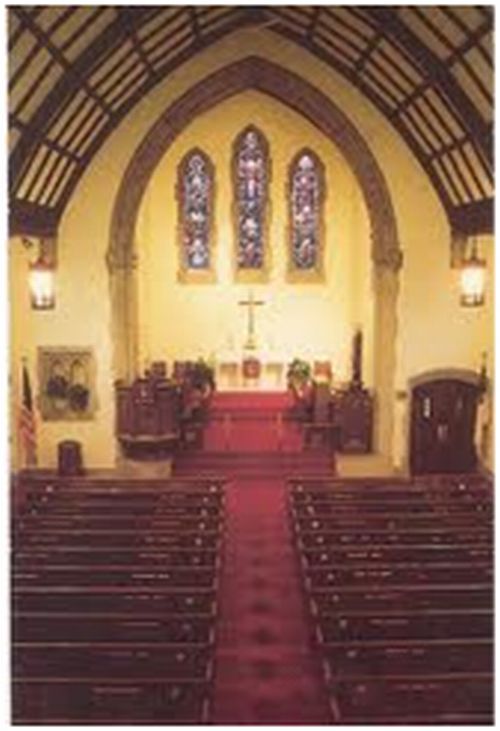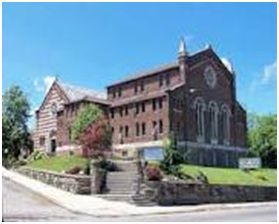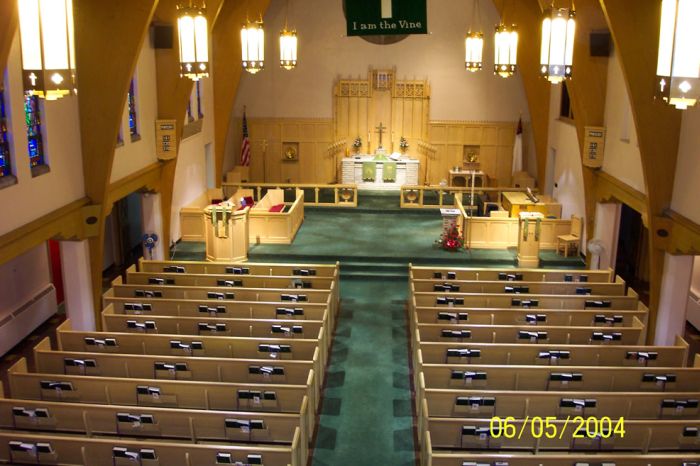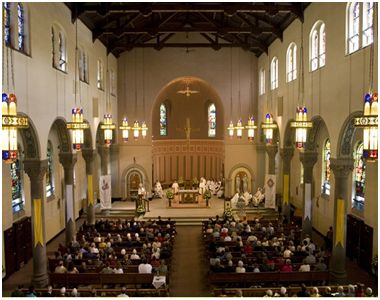Difference between revisions of "Advent Historic Church Walk"
| (5 intermediate revisions by the same user not shown) | |||
| Line 1: | Line 1: | ||
| − | + | Sunday, December 11, 2011, the first annual historical Advent Carrick Church walk took place. Visitors were invited to walk or stop at all the churches on the tour, or visit each one individually, taking time to talk to the greeters or just sit peacefully in contemplation or prayer. On a beautiful still fall day the walk was inspiring to say the least. Along Brownsville Road the tour proceeded either from Christ the Redeemer, St. Basil, Concord, Zion, St. Pius X, Birmingham and finally Stewart Avenue, or in reverse. An historic booklet was available to all describing the history of each church and the unique features. On this bright sunny day, the magnificent stained glass windows glowed, showering a colorful but venerable stillness inside making each church feel holy yet inviting and peaceful. All of the churches had their own uniqueness but welcoming atmosphere. St. Basil's even added fresh incense to fill the air, while Zion's choir and musician played for the visitors, and, while beautiful music filled the spaces at others, silence respected the solemness of others. Refreshments both hot and cold along with sweets of all kinds were available for famished pedestrians. At each church there were representatives who beamed with pride as representatives of their congregations. All welcomed visitors back for Christmas prayers, holy day masses, or just to hear warm comforting words throughout the year. | |
| − | Sunday, December | + | |
We are proud and very fortunate to have these religious and community and neighborhood minded institutions in our neighborhood each collaborating to make our little corner of Pittsburgh better. Thank you for joining together to make our holiday special. | We are proud and very fortunate to have these religious and community and neighborhood minded institutions in our neighborhood each collaborating to make our little corner of Pittsburgh better. Thank you for joining together to make our holiday special. | ||
| Line 21: | Line 20: | ||
| − | [[Zion Christian Church]] | + | ==[[Zion Christian Church]]== |
2019 Brownsville Road | 2019 Brownsville Road | ||
| Line 66: | Line 65: | ||
| − | + | ==[[The Evangelical Lutheran Church of the Redeemer]]== | |
1628 Brownsville Road | 1628 Brownsville Road | ||
| Line 127: | Line 126: | ||
[[File:St. pius booklet photo.jpg]] | [[File:St. pius booklet photo.jpg]] | ||
| − | + | ==[[St. Pius X Byzantine Catholic Church]]== | |
2336 Brownsville Road | 2336 Brownsville Road | ||
| + | |||
Pittsburgh, PA 15210 | Pittsburgh, PA 15210 | ||
| + | |||
| + | |||
Telephone: 412-881-8344 | Telephone: 412-881-8344 | ||
| + | |||
Liturgies are conducted by | Liturgies are conducted by | ||
| + | |||
Pastor, Msgr. Russell A. Duker | Pastor, Msgr. Russell A. Duker | ||
| + | |||
Saturdays at 5:30PM & Sundays at 8:30AM. | Saturdays at 5:30PM & Sundays at 8:30AM. | ||
| Line 169: | Line 174: | ||
| − | + | ==[[Birmingham United Church of Christ]]== | |
| + | |||
| + | [[File:Rooster church 1.jpg]] | ||
| + | |||
| + | [[File:Birmingham United booklet nside.jpg]] | ||
25 Carrick Ave | 25 Carrick Ave | ||
| Line 226: | Line 235: | ||
[[File:Stewart avenue lutheran church photo.jpg]] | [[File:Stewart avenue lutheran church photo.jpg]] | ||
| − | + | ==[[Stewart Avenue Evangelical Lutheran Church]]== | |
2810 Brownsville Road | 2810 Brownsville Road | ||
| Line 273: | Line 282: | ||
| − | + | ==[[Concord Presbyterian Church]]== | |
1907 Brownsville Road | 1907 Brownsville Road | ||
| Line 319: | Line 328: | ||
| − | |||
| − | |||
[[File:St. basil's booklet.jpg]] | [[File:St. basil's booklet.jpg]] | ||
| − | + | ==St Basil Roman Catholic Church== | |
| + | |||
| + | '''[[St. Basil’s School and Church]]''' | ||
1735 Brownsville Road | 1735 Brownsville Road | ||
Latest revision as of 19:18, 26 December 2011
Sunday, December 11, 2011, the first annual historical Advent Carrick Church walk took place. Visitors were invited to walk or stop at all the churches on the tour, or visit each one individually, taking time to talk to the greeters or just sit peacefully in contemplation or prayer. On a beautiful still fall day the walk was inspiring to say the least. Along Brownsville Road the tour proceeded either from Christ the Redeemer, St. Basil, Concord, Zion, St. Pius X, Birmingham and finally Stewart Avenue, or in reverse. An historic booklet was available to all describing the history of each church and the unique features. On this bright sunny day, the magnificent stained glass windows glowed, showering a colorful but venerable stillness inside making each church feel holy yet inviting and peaceful. All of the churches had their own uniqueness but welcoming atmosphere. St. Basil's even added fresh incense to fill the air, while Zion's choir and musician played for the visitors, and, while beautiful music filled the spaces at others, silence respected the solemness of others. Refreshments both hot and cold along with sweets of all kinds were available for famished pedestrians. At each church there were representatives who beamed with pride as representatives of their congregations. All welcomed visitors back for Christmas prayers, holy day masses, or just to hear warm comforting words throughout the year.
We are proud and very fortunate to have these religious and community and neighborhood minded institutions in our neighborhood each collaborating to make our little corner of Pittsburgh better. Thank you for joining together to make our holiday special.
And thank you to all for participating and to the institution taking their time to cordially invite us all into their "homes." I am sure many will accept your invitations to be part of your celebrations now that they had a chance to see inside.
Contents
- 1 Historic Booklet
- 2 Zion Christian Church
- 3 The Evangelical Lutheran Church of the Redeemer
- 4 St. Pius X Byzantine Catholic Church
- 5 Birmingham United Church of Christ
- 6 Photo of the inside of the church
- 7 Stewart Avenue Evangelical Lutheran Church
- 8 Concord Presbyterian Church
- 9 St Basil Roman Catholic Church
Historic Booklet
Cover:
CARRICK COMMUNITY CHURCH WALK SUNDAY DECEMBER 11TH 1:00 – 4:00 PM
Zion Christian Church
2019 Brownsville Road Pittsburgh, PA, 15210, USA Phone: 412-886-1864 www.zioncc.org
The beautiful Sanctuary and accompanying rooms that Zion Christian Church worships in have some absolutely breath-taking stained glass windows. While the Cornerstone was laid in 1926; some of the Stained Glass windows were built at a somewhat later time.
Originally named Bethel Baptist Church; this Church was planted by a Baptist Church in the South Side of Pittsburgh. It became a well established congregation fairly quickly. Hornaday Road at the time was a Gated Road; and home to some Banking and Steel executives. These executives proved invaluable in helping the construction of the building proceed during the difficult years of the 1920's.
The large stained glass window on the Madeline Street side of the building was not original to the building. As various individuals passed on into Glory; their families gave remembrance gifts that allowed this window to be purchased and installed. In the 1930's things were going so well for the congregation that they needed additional room for worshipers. An innovative answer was found. A wall that can raise into the attic via an electric motor was built between the Sanctuary and the Fellowship room that allowed overflow seating for more than seven hundred people in total. There is a photograph of an Easter Sunday in the mid 1930's where the wall is raised and both rooms were filled with worshipers.
Bethel Baptist's mother church ran into difficulties, and the mother church merged with the daughter church in Carrick with a new name: Union Baptist Church. Union Baptist Church enjoyed a long and wonderful period of ministry. Seasons do change; and in 1999 a combination of serious challenges, difficult problems, and a greatly reduced membership arose that led eventually to the Congregation to seek a purchaser for their buildings.
At the same time; Zion Christian Church; then meeting for eight years in Howard Johnson's Hotel in Pleasant Hills, was told that the Hotel had been sold and we would need to find new accommodations. Our Congregation began a series of weekly meetings for prayer and fasting.
Union Baptist heard about our plight; and invited us to see their building and hold a Service here. Upon walking into the Sanctuary; I knew two things immediately. First, God had been honored in this Sanctuary for a long time. Second; it was to be our new home.
Eventually we reached a purchase agreement to buy the building from Union Baptist. They had a Congregational meeting to discuss and vote on the purchase; then some representatives from Union Baptist came into our Worship Service to report on their Congregational meeting. "I have an announcement to make" I was told, "but I won't tell you what it is". So after one song, I invited the gentleman to make his announcement. "We voted not to sell you the Church and the Parsonage" he stated to the startled gasps of the Congregation. "A second vote was taken; and we voted unanimously to give you the Church, the Parsonage, and everything in them as a free gift" a second gentleman stated.
We could not even have a Service after that. People were crying, laughing, hugging, praising God, you name it; from both Congregations. Holy pandemonium. A great miracle had occurred on the basis of the selfless love and sacrifice of the wonderful people of Union Baptist Church.
We are a small congregation, but we have a big foot print. The Elder-Ado Senior Citizen's organization meets weekdays in our cafeteria; and our partnership with them has been a blessing, serving the needs of seniors in this building for over 35 years.
Our Food Pantry has over 280 households registered to receive a monthly distribution and truly is a model of organization. The Volunteer staff go out of their way to make Distribution day a warm and enjoyable time. We will once again be providing Christmas gifts this year for all qualifying children in the Food Pantry in 6th Grade or under.
Our Youth Outreach helps over 50 Community youth a week with a wonderful Youth Group, free drinks earned at our Coffee Shop, and a hot meal every Tuesday evening. It such a joy to see these children begin to thrive in an atmosphere of God's love and acceptance.
Through our Partnership with Jewish Family & Children's Services; we have become a major center for help for the growing Bhutanese Refugee population . In addition to providing Office Hours for JFCS at the Oasis Coffee Center; we are assisting many Refugee families with clothing, groceries, furniture, transportation, first part-time job experience, and a whole lot of friendship and love.
The Oasis Coffee Center is a place where a great variety of organizations and individuals hold private meetings and parties of various types. Our Youth group can earn free specialty drinks for good attendance and behavior here; and we have become a center for wonderful Christian Concerts all ages can enjoy right here in Carrick.
We do most of the things typically associated with churches. We have Jr. Church, Men's and Women's meetings, dinners and fellowships. But mostly what we are known for is being a Congregation with warm, loving hearts and a very rich and intimate worship life. God's Presence is felt powerfully by people when they come in; and that is the best blessing of all.
Pastor Dan Cramer - Lead Pastor Pastor Correy Limerick - Young Adult's & Youth Pastor Charlene Cramer - Women's Pastor & much more Ed Friedenberger - Worship Leader Janet Whetsell - Food Pantry Coordinator
The Evangelical Lutheran Church of the Redeemer
1628 Brownsville Road Pittsburgh, Pennsylvania 15210 Church Phone: 412-881-4404 E-mail: redeemercarrick@verizon.net
A Brief History
In 1901 the Pastor and members of Grace Lutheran Church observed that there was a growth of population along Brownsville Road. They proceeded to visit persons in that area to determine the feasibility of a new church. Ground for a building was broken on November 1902. Grace Church encouraged their members living in that vicinity to help create the new church.
The cornerstone for the building was laid April 19, 1903. The first worship service was celebrated May 23, 1903. The building was dedicated September 20, 1903 and the congregation was officially organized and accepted April 4, 1904.
By 1910 the congregation numbered 192 members. In 1922 the Rev. Herbert Messner became the Pastor and the church would flourish during the next 37 years of his pastorate. He was gregarious, visited most of the homes in the area, encountered people in public places and the congregation grew. The building was remodeled in 1926. By 1948 the membership grew to 1500 souls, with several hundred in attendance at Sunday Church School. Confirmation classes were large; many with 40 or more confirmands.
The much needed Educational Building was completed May 1959. Pastor Messner retired November 22, 1959, exactly 37 years after his arrival at Redeemer Church. Pastor Richard Bartley arrived in 1960 and both revived and help create groups and organizations in the congregation. In 1961 the chapel was dedicated, and continues to house the mid-week Lenten and Advent services.
The Rev. David Jensen became the Pastor in 1964. He was the Director of "Listening Ear", a 24 hour telephone counseling service which was enabled by a trained corps of laity. During his Pastorate, the renovation of the sanctuary was accomplished.
Perhaps one of the saddest moments in the congregation's existence was the death of Pastor Richard Hopf, who died after serving 20 months. The congregation knew him as a most caring and compassionate leader. In the 100th anniversary booklet we read these lines of remembrance:
"He cared for his people. He fought his illness until he had no strength left, yet his last and greatest concern was for our congregation. He showed us how to unite as one where there was division; he taught us compassion, forgiveness, caring and love. We thank God for the privilege of knowing him, loving him, and the impact he made in our lives."
Redeemer Church celebrated her 100th anniversary on November 9, 2003. For 100 years the congregation has proclaimed the Word and Gospel of Christ, celebrated the Holy Supper, prayed for themselves and the community and the world, gathered to sing praise of God and to be nurtured and sent by God; Father, Son and Holy Ghost.
It has served others through counseling ministry, food bank, clothing distribution, and weekday Christian education for youth.
Redeemer is wholesomely proud that four of her sons and daughters have been ordained as Pastors of the Lutheran Church. They are:
Charles Stadler- ordained 1969
Elizabeth Platz- ordained 1970
Carl Jensen- ordained 1972
Emilie Theobald- ordained 2008.
The Rev. Elizabeth Platz was the first woman to be ordained to ministry in the Lutheran Church in North America. A celebration of her 40th anniversary of ordination was held at Redeemer Church in November 2010.
The congregation currently hosts an A.A. group, 2 N.A. groups, an Al Anon group, a veteran’s organization, and English as a Second Language classes for the Bhutanese friends who live in Carrick.
The congregation is quite small in number. Approximately 35 persons worship each Sunday. We are increasing in age and declining in membership.
The final words in the 100th Anniversary Booklet provide a fitting conclusion to this brief history.
"Redeemer's future is uncertain as this time. We can lift our future to the hands of God and know that He will lead us and guide us to a healthy, vital and enthusiastic House of God."
We continue to gather and sing, listen, speak, pray, eat and drink the Body and Blood of Christ, do liturgy, hear the Word and do it, and be blessed by God to be a blessing for others.
The Rev. William A. Hower
Interim Pastor since November 15, 2005
St. Pius X Byzantine Catholic Church
2336 Brownsville Road
Pittsburgh, PA 15210
Telephone: 412-881-8344
Liturgies are conducted by
Pastor, Msgr. Russell A. Duker
Saturdays at 5:30PM & Sundays at 8:30AM.
St. Pius X Byzantine Catholic Church was established June 1954 to serve the spiritual needs of Byzantine Catholics of the Pittsburgh Central South Hills areas. The existing church building was dedicated on May 19, 1974 which also commemorated the May 19, 1954 canonization of our parish’s patron saint, Saint Pius X. Our Divine Liturgy was penned by Saint John Chrysostom, Archbishop of Constantinople in the 5th century. Today this same Liturgy is celebrated almost entirely in English. Both priest and congregation sing their participation.
Byzantine Catholic churches are all designed essentially in the same fashion. Below are some key facts and features:
ICONs. As you tour our church, our century’s old tradition of venerating icons is evident. The icons are not just art objects but rather scared objects which foster devotion and piety. The honor given to an icon is only veneration not adoration which is given to God only. Feeling closer to God and to things divine is the desired result of our veneration of icons. The ceiling as your enter the church is painted with stars to depict “the heavens”. It reminds us that the entire Body of Christ, in heaven and earth, is coming together to worship.
Saints Cyril and Methodius. As you walk into the church, these “Saints of the Slavs” are holding a scroll of Saint Paul to the Ephesians from which our parish’s motto of “With Truth and Integrity” is derived.
Chapel of Remembrance & Shrines. This area situated to your right upon entry is dedicated to the Mother of Perpetual Help, our forefathers, founders and martyrs. Artifacts from the “old country” regions are displayed in the glass cases.
Most Holy Godbearer. The Protection of the Mother of God is depicted by the extremely large icon in back of the altar. It shows Mary’s arms extended with her protecting veil. Mary is our heavenly Mother interceding for us and our efforts to protect & defend human life from conception through natural death. We extol her as the Godbearer, the woman who actually gave flesh to the eternal Son of God. The Vatican, Rome is shown in front of Mary. As her icon directs us to the altar, Mary always directs us to Jesus.
King of the Universe. On the highest part of the ceiling above the altar, the icon of Christ as King of the Universe is shown along with the Greek letters of alpha and omega (beginning & end). Jesus rules throughout eternity!
Modern Day Martyrs. To the right of the Mary icon are the four holy Ruthenian bishops: Blessed Theodore George Romzha, Blessed Paul Peter Gojdich, Venerable Alexander Chira and Blessed Basil Hopko. During the recent period of communist persecution in Central and Eastern Europe, these four exemplary advocates intrepidly defended their Catholic convictions. They are relentless intercessors before the throne of Almighty God for all who struggle to remain faithful to the Lord Jesus and to His blessed Kingdom on earth – the Church. We continue to offer prayers for their eventual canonization as saints of the entire Holy Catholic Church.
Ancient Holy Hierarchs. To the left of Mary icon are the three holy Hierarchs: Basil the Great, Gregory the Theologian, John Chrysostom and Saint Athanasius. The early church’s pride for these teachers lead to competition and church division. This was healed when Saint John Mauropus, the Metropolitan of Euchaïta dreamed and received instruction from all three Hierarchs as follows: “As you see, the three of us are with God and no discord or rivalry divides us. Each of us, according to the circumstances and according to the inspiration that he received from the Holy Spirit, wrote and taught what befits the salvation of mankind. There is not among us a first, a second or a third.” As a result, the feast of all three Hierarchs is celebrated on January 30. Saint Athanasius (296-373) insisted that Arianism, the reigning "orthodoxy" of the day, was in fact a heresy. To Athanasius, the logic of New Testament doctrine of salvation assumed the dual nature of Christ. "Those who maintain 'There was a time when the Son was not' rob God of his Word, like plunderers." Emperor Constantine the Great called a council of bishops at Nicea to end the dispute and eventually fleshed out an early version of the Nicene Creed. The council condemned Arius as a heretic, exiled him, and made it a capital offense to possess his writings. Athanasius, whose treatise On the Incarnation laid the foundation for the orthodox party at Nicea, was hailed as "the noble champion of Christ."
Iconostasis [Greek: “eikon”-image; “stasis”-stand, support] separates the sanctuary from the nave of the church. Here at St. Pius, our iconostasis is a “work in progress”. We have yet to purchase its doors. The four icons screens are set up in the traditional manner and are the same in all Byzantine churches:
To the right: Christ the Teacher and the parish’s patron saint, St. Pius X. To the left,: Blessed Mother holding the infant Jesus and St. Nicholas, the patron saint of the Byzantine Catholic Church.
Apostles of the Slavs. Our Ruthenian ancestors were converted in the 2nd half of the 9th century by SS Cyril and Methodius. (icon on the far right) In 1981, Pope John Paul II proclaimed SS Cyril and Methodius Co-Patrons of Europe, to link their missionary and cultural work to that of St. Benedict.
Founders of Russian Christianity. Large icon on left front is Olga & Vladimir. Olga born in about 890, was the wife of Prince Igor of Russia, and after his death in 945 she was regent for their son. In 957 she visited Constantinople and, either then or earlier, became a Christian. She did not succeed in converting her son, or a significant number of their countrymen. She died in 969. Olga’s grandson Vladimir appeared to convert to Christianity for purposes of a political marriage. He married Anna the sister of the Byzantine emperor Basil II. However, Vladimir took his Christian commitment seriously. He removed himself from his former pagan wives/mistresses, destroyed idols & pagan temples, built churches, monasteries and schools, brought in Greek missionaries to educate his people, abolished or greatly restricted capital punishment, and gave lavish alms to the poor.
Birmingham United Church of Christ
25 Carrick Ave
Pittsburgh, PA 15210
Phone: 412-881-6282
birmingham_ucc@verizon.net
People often say, "If only these walls could speak, what stories they might tell!" Our present church building is certainly no exception, and its history, combined with the history of the two buildings preceding it is a fascinating ac¬count of the faith, hope and love of an interesting, vital and living group of people--the congregation of the Birmingham United Church of Christ.
EARLY HISTORY
In the early 1800s, a group of people originally from Germany settled in the area of South Side known as the Borough of Birmingham. Since there was no German speaking Evangelical Church in their own area, they traveled to the Evangelical Church on Smithfield Street, Downtown Pittsburgh.
As more and more Germans moved to the Borough of Birmingham, they began to realize the practicality of having their own church in their own area, one which would answer their spiritual needs and also house a German school. It was their desire that their children be educated in the German language, both for continued use of German in worship and that they retain an appreciation for the beautiful customs and heritage of their forefathers.
On January 5, 1846, a group of men representing the congregation met for the first time. The name they chose for their church was The German United Evangelical Congregation of the Borough of- Birmingham. They received their official charter on June 27, 1846. The first worship services of the Birmingham Church were held at the Presbyterian Church, formerly located on Fourteenth Street.
The first pastor of the church was the Reverend Hohann Christopf Jehle, who served from 1846 to 1849. Space does not permit a complete account of all of the ministers who served the Birmingham Church., but among the most notable was Reverend Philipp Jakob Zimmermann, for whom our present cemetery was named.
Reverend Zimmermann had been educated and ordained in Germany. Due to his zealous work for liberty in his native Baden, he was sentenced to a life-long term in prison. After serving a short portion of this term, he was given the op¬tion of continuing his prison sentence or spending the rest of his life in exile.
He came to America and was for a time Pastor of the Smithfield Church, before accepting a call to come to Birmingham, where he preached in their first building, located on Tenth and Bradford Streets. At the time they built their first building, the young and growing congregation was able to also purchase one-half acre of land on Brownsville Road; this was the first cemetery.
In 1862 the ladies of the congregation formed the so-called "Frauen Unterstuetzungs Verein," or Ladies Auxilliary Society. Three years later, the congregation decided to purchase 'a building site for a new church building, which would be larger and better equipped to serve their needs. On August 9, 1866 the cornerstone was laid, and in the year 1867 they dedicated the new building and purchased a parsonage at the corner of Seventeenth and Jane Streets.
On October 49, 1913 Reverend Otto Eisele became pastor of the Birmingham Church, and he was the first pastor to begin instituting worship services in English. Up until that time all worship services were conducted entirely in German, but with the decline of the German School, many of the young people could no longer understand German well enough to worship entirely-in that language.
At first, English services were held on Sunday even¬ings, but in time there were two morning services, the first of which was¬ German, followed.,, by English, Under Reverend Eisele 's leadership the Lincoln Bible Class (so named because the first meeting of this class took place on - President Lincoln's birthday, and because the congregation valued Lincoln's ideals of .freedom of thought and speech, which so well reflected their own feelings), the Friendship Bible Class, the Cradle Roll and the Sewing Circle came into being.
The year, of 1924 was another, important one for the Birmingham Church. After much discussion and prayer, the congregation voted to become af¬filiated with the General Council of Congregational Churches. They felt that in so doing they would not be giving up their ideals of freedom and in¬dependence, but instead would be joining with others who shared these same ideals and who could offer assistance and suggestions for growth.
In 1926 the Birmingham Brotherhood was founded. In the same year the church celebrated its eightieth anniversary. Reverend Eisele compiled and published a bilingual book with many photographs for this event which was a further milestone in the life of the congregation.
During the years following, several crucial decisions had to be addressed by the congregation; these decisions were to be of great significance to the con¬gregation then and now. In the year 1937 a new pipe organ was purchased and installed. In 1943, July 18, the congregation voted to start a building fund campaign. The present building site was purchased in 1945, and in 1946 they sold a building site that they had previously purchased on Ormsby Avenue.
HISTORY OF THE PRESENT CHURCH BUILDING
Our present church building was designed by architect Harvey A. Schwab. The contractor was Henry Busse. On February 25, 1951, the congregation dedicated their new church building. Built in the Gothic style, the church proper is of the chancel type, with a center aisle and two side aisles. Especially noteworthy are the beautiful marble altar, the many stained-glass windows depicting scenes from the life of our Lord, Jesus Christ, the high ceiling with its partially exposed beams reminiscent of many of the buildings in Germany, and the wooden pulpit, slightly elevated, from which the true gospel is still preached every week.
In 1957, the Congregational Christian Churches voted to align themselves with the Evangelical and Reformed Churches, and the Birmingham Congregational Church voted to become part of this new denomination in the year 1964, a decision that is both in keeping with the Evangelical origins of the church and the desire for freedom that was behind the decision to join with the Congregational Churches back in the year 1924.
Since that time, the Birmingham Congregational Church carries the name Birmingham United Church of Christ, name that reflects the rich and varied heritage of our church and also points to Jesus Christ, our Lord.
The Birmingham Church is still a church with a vital, living ministry. The best testimonial of the church as a whole comes in the form of the com¬ments that our visitors make. Many have said and continue to say that the- Birmingham United Church of Christ is one of the most caring and friendliest churches they have attended.
Birmingham United Church of Christ: One-Hundred and sixty-five years young, years of Faith, Hope, and in all things Love. May we all remember with pride the accomplishments of our founders, may we work to do the will of God in all things, and may we look forward to the future with the same optimism and renewed vigor that our founding members had long ago.
Photo of the inside of the church
Stewart Avenue Evangelical Lutheran Church
2810 Brownsville Road
Pittsburgh PA 15227
Phone: 412-881-0171
www.stewartave-lutheran.org
The need of establishing a church in this community was keenly felt by the Pittsburgh Lutheran City Mission society, back in 1919. Canvassing the field showed that the time was ripe for action. There were many Lutheran families who could be interested in organizing a mission congregation. Prospects of winning souls for the Lord were also promising. Everything pointed to the necessity of going together with our City Mission Society, in purchasing the choice location at the corner of Brownsville Road and Stewart Avenue for the sum of $11,000.
The first house of worship was a renovated barn, the gift of Mr. Claus, from whom the property had been purchased. It was a humble beginning, indeed; this barn, converted into a Chapel. Yet wasn’t our Savior born in a lowly stable? So the memory of this humble beginning is especially cherished by us.
The first meeting was called together by the Rev. Fred O Schuh, then pastor of Zion Lutheran Church Brentwood. The records reveal that this meeting was attended by six people. At the next meeting a week later temporary officers were elected. Saw horses were used for chairs, and an oil lantern, with its flickering light, illuminated this first service.
The Chapel was dedicated on the first Sunday in May, 1920; when an overflow crowd taxed the capacity of this modest building. At a meeting held on Sunday afternoon, May 23, 1920, the new congregation was permanently organized as “The Stewart Avenue Evangelical Lutheran Church of Carrick:. This name was a natural selection inasmuch as the new church had been generally referred to as the “Stewart Avenue Mission.”
We are deeply indebted to the Zion Lutheran Church, Brentwood, for granting us the services of Rev. Schuh, as supply pastor during those early months of our beginning. The first few worship services were held in the afternoon. But this soon proved unsatisfactory. Pastor Schuh then received the consent of Zion congregation to absent himself from his own Sunday school in order to conduct worship at Stewart Avenue in the morning. Zion congregation also generously released a considerable number of her members, residing in this vicinity, that they might unite with the new Mission. Thus the beginning of what was to become a substantial congregation was launched. The hand of God was leading into larger fields of service.
At a meeting held on Sunday, May 23, 1920, the new congregation was permanently organized. Under the energetic and able leadership of Pastor Michelfelder the work progressed to the point where the Chapel was no longer adequate to meet the needs of the growing congregation. Plans were then formulated to begin the building of the first unit of a permanent church plant. On Sunday afternoon, July 23, 1922, an impressive service was held, when ground was broken for the basement of the Sunday School unit. The first unit of the new church was dedicated in the name of the Triune God on Sunday December 10, 1922. A great forward step had been taken. It as a work of faith and hope, misplace; for it soon became evident that the next unit of the church should be added as soon as possible.
Worship was still being held in the Basement Church when a call was extended to the Rev. Herman Meyer, who was completing a post-theological course of study in Europe. He was installed as Pastor on July 11, 1926. It was under his leadership that the 2nd unit, known as the Sunday School Unit of the church was begun in 1927. This unit was dedicated on June 17, 1928.
Plans were already underway to complete the building, by adding the third and final unit, within another five years or so. But of course the future could not be foreseen. A year later the “Great Depression” set in, which upset many of the plans. Instead of pointing toward another building project, every effort was directed toward meeting the obligations of the heavy church debt. The property, as it stood, was valued at $84,000.
Those were difficult years for the church as well as in every field of life. Projects had to be sharply curtailed. The unemployment list was growing. Man had to learn to get along on less and less. The pressure of a large building debt was becoming increasingly heavy. Principal payments had to be forgotten for the time being, as every effort was made to meet the interest. Under these rather discouraging conditions Pastor Meyer received a different call.
With little loss of time a call was extended to the Rev. John Wannemacher on January 1, 1933. The first years of his ministry here were quite difficult. The depression was in full swing. As a result there was some tension as efforts were made to meet pressing obligations. But the congregation took hold courageously and progress was made. Gradually conditions in the economic world began to improve and the burden became lighter. New life was in evidence and the congregation was gradually taking on a greater stability. What had seemed like many loose planks in the foundation, were becoming more firmly anchored together. We were reaching our maturity.
With the entrance of our country into this great global war, in December, 1941, the ranks of our youth were strongly invaded. In 1945 the church honor roll carried the names of 134 young men and women who had entered the service of our country. Many of them had been taking an active part in the life and work of the church, and their absence was keenly felt. Many men did not return from the war. One man of our congregation gave his life for his country, that being Homer Landefel who went down with his ship in the Atlantic. The pipe organ was dedicated to his honor on July 2, 1946.
With the continued growth of the congregation the pastoral work, together with the office became a burden for the pastor and church council. We then hired our first office worker, Elva Dovedot. Our membership was now numbering over 900. At that time we entered the internship program. It consisted of Seminary Students who had to serve one year before being ordained.
With growing pains and limited space for Sunday School facilities, a building fund program was begun in July, 1953 with the purpose of completing the present structure. Mr. Arthur Steinmark was the architect and D. Carapellucci was awarded the contract to complete our present church. Groundbreaking ceremonies were held on March 16, 1958.
On June 15, 1958, two important events in our history happened. The first son of the congregation Rev. Robert Sheets was ordained into the Gospel Ministry at the morning worship. In the afternoon a cornerstone laying service was held for our present building. The present sanctuary was dedicated on March 8, 1959. The overall cost, including the renovation of the old basement, was about $275,000. The mortgage of $125,000 was to be paid off in fifteen years.
In 1970 in conjunction with the Lutheran Service Society, Carol Succop, and others the South Hills Meals on Wheels was formed. In 1971 it began operating out of the Brentwood Presbyterian Church and continues operating in our own time.
On May 5, 1982, under the direction of Kay Papuga, Gertrude Weinert, and Hilda Davis, the Food Pantry was created. In that first year 800 lbs of food was distributed to forty families. Kay Papuga still directs the Food Pantry with help from many members of the church as well as the community.
The stained glass windows are a stunning feature in this church. Although the designer and installer are unidentified, the magnificent windows tell the story of Jesus ‘life and ministry. Beginning in the balcony and continuing along the left side of the sanctuary the colorful and finely detailed windows tell a beautiful story.
Concord Presbyterian Church
1907 Brownsville Road
Pittsburgh PA 15210
HISTORY OF CONCORD PRESBYTERIAN CHURCH
In the early days of our country, during the time of the French and Indian warfare, the British decided on an attempt to wrest old Fort Duquesne from the French, who then held possession. A part of the army sent for this purpose traveled over an old Indian trail which later was known as the Brownsville Road.
With the British successful in their warfare again the French and Indians, peace reigned and the pioneer settlers were no longer afraid to travel far afield and to establish homes far away from the protection of the Fort.
One hundred and fifty years ago in the month of June some thirty people, residents of this area, gathered together to consider establishing the church in the community. The nearest churches were in the city of Pittsburgh or out the road to Bethel or Lebanon, a long way by horse and buggy.
Before their first meeting ended, the group decided to petition the Presbytery of Ohio to organize them into a church. "We, the after named subscribers being deeply and solemnly impressed with the importance and necessity of having ye public worship of God established and His ordinances administered among us, do hereby agree to associate together for the above purposes. Inconsequence of our being thus associated, we applied to the Presbytery of Ohio in order to be taken under their care, and with a view of making a location for the house of public Worship, whereupon the Presbytery did at their meeting in June, 1831, receive us under their supervision and appointed a committee for fixing a site for the erection of the church."
The first house of worship was completed in May of 1832 on the site of the present structure. The first ruling elders, elected by the congregation were Messrs. Robert Williamson, John Wilson, and William Kerr. They were ordained and installed on the fourth Sabbath of July, 1832.
One interesting record concerns the call to the Reverend Samuel Henderson in 1840: "...and that you may be free from worldly cares and avocations were hereby promise and oblige ourselves to pay to you the sum of $400.00 hi regular half-yearly payments during the time of your being and continuing the regular Pastor of this Church."
The Session records record that occasionally offenders were brought before the session because of having used profanity, or perhaps on account of having imbibed strong liquor too freely, and even because of quarrels with a neighbor. These offenders accepted the situation gracefully and acknowledge the authority of the Church to correct their shortcomings.
A new house of worship was erected at a cost of $4,000. This new building was dedicated in 1884. At the beginning of her history, Concord was distinctly a rural congregation. The congregation remained small and at one time almost went out of existence. We must remember that during this period people had come to the Church and departed from it; families had been raised and migrated to other sections of the country; and new congregations were forming on the South side.
Finally, however, migration from the rapidly filling Monongahela Valley started toward higher levels, slow at first, but in sufficient volume to warrant the reorganization of Concord in 1888. But not until some 20 years later did she really change from a rural to an urban congregation, awaking from the peace and quiet of the country to the hustle and bustle of the life of a great city.
About this time a Christian physician, Dr. John W. Duff, who was a member of concord, saw a real need in the lives of the many children in this growing community. He gathered them into old Concord and taught them the blessed stories from the Bible. This revival in the Sunday Church School was soon reflected in the life of the Church. The impact of Concord Church on the community over the years has been immeasurable. Certainly it has left a mark.
It was necessary to erect the present structure in which we are now worshipping. The corner stone was laid in 1914 and the completed structure was dedicated to God in 1915. The old two-story building was rolled back to the present parking lot. For awhile the Carrick High School held its classes in the old building. This building was destroyed by fire. The street behind the church is named Concordia after the Church. The community elementary school also is named Concord.
The church is a meeting place for the American Association of Retired Persons, Order of the Easter Star, and Alcoholics anonymous. Recently the benevolence budget of Concord has been supporting the Reverend and Mrs. Robert Collins in Thailand, and the Reverend and Mrs. Alfred Scholrholtz in Nepal.
In National missions, money is sent to the Navajo Indians, Presbyterian Medical Mission in Woodville, Texas, and the board of Christian Education. In Pennsylvania, Concord supports the Pittsburgh Theological Seminary, Home for the aged, Presbyterian University Hospital, thirty Pittsburgh Presbytery missions, seven U.P. Colleges, Camp Crestfield., Pittsburgh Region International Student Ministries, and Carrick Youth Outreach.
The cassette ministry was begun in 1971 providing cassette and tapes of current sermons to the shut-ins. A nursery was donated by Mr. and Mrs. George Korpa. It is located in the rear of the lecture room. This was completed in November, 1973. Auditory equipment, including pulpit and portable microphones and speakers in the sanctuary, nursery, and social hall were installed. A memorial book, guest register, and stand were donated, as well as an outdoor bulletin board and theater type seats for the balcony.
In 1965, the sanctuary was redecorated and restrooms were remodeled. Mr. Robert A Schneider contributed $3,000 and challenged the congregation to pay off the balance in one year. Herman Barchfeld served 58 years as a faithful and devoted officer of the church. He retired from the Trustee Board in December 1970 and was honored as elder, trustee, and deacon emeritus.
An improvement program entitled, Forward to '81 included consolidating the church offices in the basement complex, replacement of the pipe organ, and sandblasting and sealing the exterior stone. This was financed by pledges from the congregation over a three year period. All contributions to the organ made the first year were matched by an anonymous donor. Keys were also bought by individuals and organization to finance the organ.
The estate of Elsie L. Donnally provided seed money to repair the stained glass windows and have them covered permanently. Members of the congregation subscribed to individual windows.
Concord Church is celebrating one hundred fifty years in Christ's service and looking forward on one hundred fifty more years.
St Basil Roman Catholic Church
1735 Brownsville Road
Pittsburgh PA 15210
Saint Basil Parish in Carrick celebrated the 100th anniversary of its founding on February 14, 2007.
Saint Basil Parish was founded when a small group of families from Carrick petitioned the Bishop of Pittsburgh in 1906 to form a new parish. Until that time, St. Wendelin Church, located in eastern Carrick, was the only Catholic parish in the area, and it was a considerable distance to travel for the many people living along Brownville Road.
In March 1907, some land was acquired at the corner of West Cherryhill Street and Brownsville Road, and early plans were drawn up for the construction of a large red, rectangular, combination church and school building. The architect was Thomas Comes, one of Pittsburgh’s greatest architects.
In 1922, to accommodate the ever-growing congregation, Father Charles J. Steppling proceeded with the construction of the present church on the same piece of property as the parish house, just a little to the right of it, at 1725 Brownsville Road. The Pittsburgh Catholic newspaper gave the following description of the new church:
The new church takes its place as one of the purest types of basilica in this state. With walls of brick and stone, the floor is of mosaic, with a center aisle in cork. The sanctuary is a deep and wide spacing in bordered mosaic of subdued tones to carry through the warm airy atmosphere of the gray limestone which makes the 14 great columns with Corinthian capitals dividing the nave on both sides and which in tone completes the whole interior.
The windows flood the church with a glorious array of color and fire by day and they are marvelously beautiful from the exterior by night. Father Steppling noted that the picturization and the designs were drawn and windows made in Holland.
In the sanctuary on the right side is the window of “The Sacrifice of Melchiesedech,” and on the left side is “The Lords’s Supper”. On the left wall of the nave are in succession The Sacred Heart, St. Basil, (patron of the church) St. Gregory Nazianzus, Christ Blessing the Children, The Annunciation, St. George, St. Francis Seraph, St. Benedict; on the right side The Holy Family, St. Ambrose, St. Augustine, St. Charles and St. Aloysius, Christ Giving the Keys to St. Peter, St. Henry, St. Joseph, St. Rose of Lima.
St. Basil Church is a brick construction of Byzantine architecture. The one tower that it possesses houses three bells which ring forth to remind all the faithful of the specific liturgical function that is to be enacted. The bells are named Saint Aloysius (from the first church) donated by Mr. Aloys Winter; Saint Charles (the largest bell) donated by Charles Lanz; and Saint Barbara donated by Barbara Winters. The bells are operated electronically from the sacristy.
The windows of the upper clerestory (the highest story of the nave of a church, with windows opening above the aisle roofs) are double, each pair being in the arch section between the pillars (the original cost of each window was $60). A large rose window showing Christ and the Four Evangelists (Matthew, Mark, Luke and John) adds to the beauty of the front of the church. See our booklet: Church Windows of St. Basil (located at the entrance of the church) for a fuller description.
Upon entering Saint Basil Church, you are greeted by two four-foot tall white marble angels, each holding a vessel of holy water. They were donated by Mr. and Mrs. Joseph Dieterle and Mr. Raymond Winters. Off the vestibule to the right, currently the candle shrine, was the site of the baptistry. The window in the baptistry depicts Christ being baptized by John in the Jordan River (donated by the Christian Mothers). The baptismal font is now located in the sanctuary to the right of the altar. The Sorrowful Mother in the shrine was also later donated by the Christian Mothers. The statue of Saint Basil in the niche outside the church (high above the front doors) was donated by Thomas McGovern.
Saint Basil Church stands unsurpassed for its beauty of style, originality of design, and fineness of workmanship. It remains the spiritual home of nearly 2,400 Catholic Christians in Carrick and the neighboring areas.
PARTICIPATING CHURCHES
STEWART AVENUE LUTHERAN CHURCH 2810 Brownsville Road
BIRMINGHAM UNITED CHURCH OF CHRIST
25 Carrick Avenue
ST. PIUS X BYZANTINE CATHOLIC CHURCH
2336 Brownsville Road
ZION CHRISTIAN CHURCH
2919 Brownsville Road
CONCORD PRESBYTERIAN
1907 Brownsville Road
ST. BASIL ROMAN CATHOLIC
1735 Brownsville Road
LUTHERAN CHURCH OF THE REDEEMER
1628 Brownsville Road
